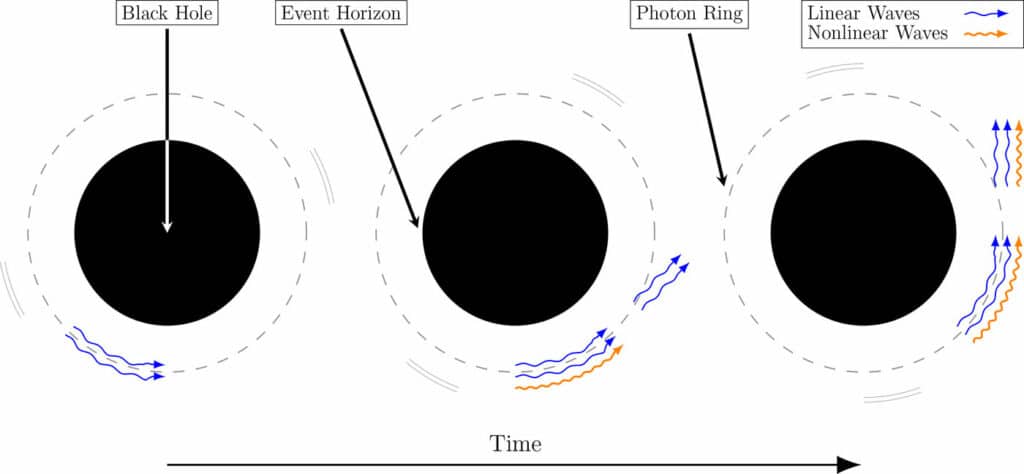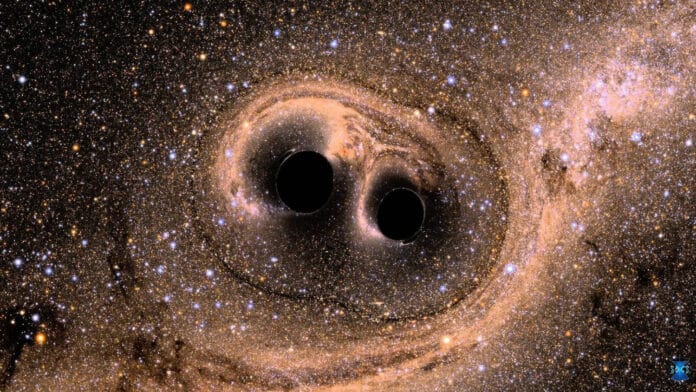Black hole collision generates a new bigger black hole. The collision violently roils spacetime around, sending ripples called gravitational waves outward in all directions.
Prior research on black hole collisions analyzed gravitational wave behavior using linear math, implying that the gravitational waves that rippled outward were independent. Now, new research has more precisely modeled the same collisions and exposed so-called nonlinear effects.
When waves on the beach crest and crash, nonlinear effects occur. Instead of traveling in isolation, the waves interact and impact one another.
Keefe Mitman, a Caltech graduate student who works with Saul Teukolsky (Ph.D. ’74), said, “We anticipated these effects with something as violent as a black hole merger, but we had not yet observed them in our simulations. The waveforms from our simulations may now be extracted using new techniques, making it possible to observe the nonlinearities.”
In the future, the new model can be used to learn more about the actual black hole collisions routinely observed by LIGO (Laser Interferometer Gravitational-wave Observatory) in 2015.
A group named the Simulating eXtreme Spacetimes cooperation, or SXS, includes Mitman and his coworkers. The SXS project, started by Teukolsky in collaboration with Nobel Laureate Kip Thorne (BS ’62), Emeritus Richard P. Feynman, Professor of Theoretical Physics at Caltech, simulates black hole mergers using supercomputers.
Using the equations from Albert Einstein’s general theory of relativity, supercomputers simulate how black holes evolve when they spiral together and merge. Teukolsky was the first to realize how these relativity equations could be used to simulate the “ringdown” phase of the black hole collision, which happens immediately after the two huge entities have fused.

Teukolsky said, “Supercomputers are needed to carry out an accurate calculation of the entire signal: the inspiral of the two orbiting black holes, their merger, and the settling down to a single quiescent remnant black hole. The linear treatment of the settling down phase was the subject of my Ph.D. thesis under Kip quite a while ago. The new nonlinear treatment of this phase will allow more accurate modeling of the waves and eventually new tests of whether general relativity is, in fact, the correct theory of gravity for black holes.”
The roughly 100 black hole mergers that LIGO has so far observed have all been identified and described, thanks in large part to the SXS simulations. The team has discovered nonlinear effects in ringdown phase simulations for the first time with this new study.
In the big picture, these new simulations will help researchers to characterize better future black hole collisions observed by LIGO and to better test Einstein’s general theory of relativity.
Co-author Macarena Lagos of Columbia University said, “This is a big step in preparing us for the next phase of gravitational-wave detection, which will deepen our understanding of gravity in these incredible phenomena taking place in the far reaches of the cosmos.”
Journal Reference:
- Keefe Mitman, Macarena Lagos et al. Nonlinearities in Black Hole Ringdowns. Physical Review Letters. DOI: 10.1103/PhysRevLett.130.081402
